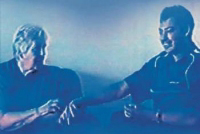
|

|
|

|
 Home
Home  Autism
Autism  Responsive
ResponsiveCommunication   Intensive Interaction
Intensive Interaction  Media Articles
Media Articles  Feedback
Feedback  Simple Handouts
Simple Handouts  References & Links
References & Links  Films
Films  Contact Me
Contact Me |

Intensive InteractionAt the same time as paying attention to sensory deficits, we use Body language to express how we feel, as opposed to what we are saying. We all use it all the time - we want to know if what our conversation partner is saying matches up to their affective state. 75% of our conversations with each other is about how they feel. So the idea of using it to tune in to people who have little or no language is not strange. Based on the first way the infant learns to communicate with its mother, using body language gives us physical confirmation of what we are doing. (If I see you, I not only get visual information about you but also a second message to the brain which tells me that my eyes are seeing you.) So, in perceiving the world outside, I learn about myself. But if the signals coming in to the brain are skewed as in autism, it is going to affect how I perceive my physical self, I am not going to get the confirmation I need from the world outside. This process lasts throughout our lives, so using body language to communicate can be used with adults as well as children, it does not infantilise the conversation partner but is part of normal interaction. Based on imitation, the infant initiates a sound or movement, the mother confirms this and (eventually) the baby moves on. For example, the infant may say, 'Boo' to which the mother responds, 'Boo', confirming what her baby has said. After some trial and error, the baby moves on to try out another sound, say, 'Da'. The point being that the baby learns that if it makes an initiative it will get a relevant response. Intensive Interaction is a way of working with the child (or adult's) brain using signals with which it is so familiar that they do not trigger sensory distortions or sensitivities. It uses the child's own body language to build up emotional engagement. It begins with observation. What is this child doing? What are they focusing on? We need to look not only at their face, but all their bodily behaviour. Are they scratching their hands, wriggling their feet? We also need to look at any activities that focus on a particular aspect of the world outside themselves. The multitude of ways that are available for the brain to fixate on range from as little as breathing rhythm, to fixations on certain activities or themes such as Thomas the Tank Engine, specific computer programmes - or certain tunes or movements. What they have in common is that they allow the child to cut down on the external stimuli which are overloading their brain, focusing instead on a conversation between their brain and the sensation they are getting from the stimulus. For example, the brain may say to the finger, 'scratch your hand' and the hand will send back a sensation message to the brain saying that it has done this. Since the autistic brain often has difficulty in switching off messages, it is easy for it to get caught up in a repetitive dialogue between itself and the source of its feedback, a 'Do this - Done it', Brain-Body Conversation that goes on and on (perseverates) and makes it difficult for us to get their attention. These repetitive behaviours are more than just 'comforting'. They are the language that the brain understands as significant without having to go through elaborate processing: their sounds or images or feelings seem to be hard-wired in. Far from trying to stop such behaviours, we are going to use them to gain access to our child or adult partner's attention, rather in the same way as we use a smart card. Once we have the correct pin number we have no difficulty getting in to their account. Particularly with children and adults with autism we can use this approach to bypass the processing difficulties they experience. We are trying to shift our conversation partner's attention from solitary self-stimulation to shared activity, remembering that what is important is not just what they do but how they do it. What does how they are doing this activity tell us about how they are feeling? Are they stressed or relaxed, interested in our empathetic responses? Do they want more? As soon as their brain perceives something that it recognises as part of its own repertoire, attention is attracted in the same way as iron filings to a magnet. So we look at what the child is doing. What we are interested in is not their cognitive capabilities but what they do when they are 'doing nothing' - that is, nothing that we would recognise as organised activity. Nor must we be judgemental about their activity if they are focusing on something we might wish to discourage, for example, touching the walls, spitting, rocking or banging their heads. It may not be what we want them to do but this is what has meaning for them. In the midst of sensory confusion, when they do it they know what they are doing. We have to learn their language so we can begin to have a conversation with them. Like the infant, the child needs to know that when they make a sound or movement, they will get an answer. The question is, what is the most effective way of building this bridge between us? If we just mimic, we catch the child's attention but after a while there is a tendency to lose interest. Interaction flags. One of the questions often asked, 'what do we do next?' The answer is that rather than just imitating what the child is doing, we need to treat everything they do as elements of a language and think of our responses to their initiatives like open ended conversations. Using elements of their repertoire we respond in ways that echo their rhythms but also put them in a slightly different way, something like jazz where you have a theme and variations. For example, in answer to a sound, 'er-er' I might make the same sound, 'er-er' (imitation). Or I might make the same sound but elongate it, 'eerrr', or shift the pitch up or down, or lift it at the end (a good way of asking a question). I might alter the rhythm. Or I might shift the mode, answering the sound with a tap, or draw the shape of the sound on their arm. All of which gives the brain something it recognises but also, a slight 'jolt' - 'that's something I recognise but it's slightly different'. It is the 'difference' that shifts the child's interest from attention (that's something out there I recognise) to engagement (I want more of this.) At this stage they become interested in the source, starting to following up their initiative by looking back to their conversation partner to see what they make of it. At the same time, we are using empathy to tune in to their sounds or movements but we are not using words, since words are difficult to process. Our aim is to interact with the child's brain in a way that does not raise their stress level. What we do find is that, as the brain relaxes, the child becomes capable of a range of activities not normally associated with the autistic spectrum. Using frame by frame analysis of Intensive Interaction films, Zeedyk, Caldwell and Grffiths (see reference list) have shown that eye contact increases, the conversation partner moves close and they are generally more socially responsive. But also, as the stress level falls there are also some cognitive improvements, such as the ability to generalise (within the limits of their disability), refer back and particularly, to be able to copy hand movements. Aloneness becomes shared interest. As their perception of the world becomes less scary their behaviour and capacity to join in the world round them normally improves. They show pleasure and want to interact. |
Recent and Upcoming Work
|
|
The text of this page is available for modification and reuse under the terms of the Creative Commons Attribution-Sharealike 3.0 Unported Licenseand the GNU Free Documentation License (unversioned, with no invariant sections, front-cover texts, or back-cover texts).
|
